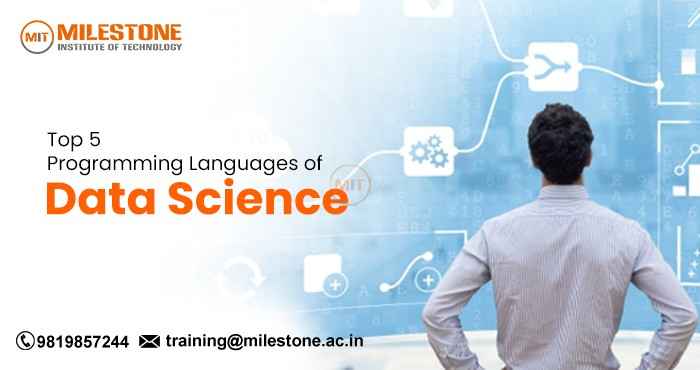Top 5 Data Science Languages You Need to Know in 2025
Data Science opens up valuable insights from data and is changing the landscape of industries across the world. It is also one of the most important points for data scientists, data analysts and AI engineers as it is essential to choose the right programming language. In this blog, we discuss the 5 main Data Science Languages, the benefits of Data Science Languages, and why Data Science Languages are required by Data Science professionals.
Importance of Data Science Languages
Programming languages are not just used for handling raw data in data science. They assist us in data manipulation, data analysis, data visualization, machine learning, artificial intelligence, and deep learning. Using one critical language can take complex computations, make them manageable and more efficient, enabling teams to drop context and continue working seamlessly. In this article, we will discuss the top Data Science languages that drive the Data science apps of today.
Python
There is no doubt that Python is the leader for
Data Science due to its ease of use, general-purpose, and computational capabilities with libraries. This data science language has wide acceptance in the industry.
Advantages:
- Easy to learn and great for beginners
- Supports various paradigms, such as object-oriented and functional programming
- Well scalable, from small scripts to enterprise-level applications
- Well, very supportive community and very active development
- Deep integration with AI and machine learning frameworks
- Libraries like Pandas, NumPy, Scikit-Learn, and TensorFlow for advanced data operations
- Web development frameworks support e.g., Django and Flask
2.R
R is widely used for data visualization and analysis, it is a statistical computing powerhouse. Here is the importance of R among Data Science Languages, especially for researcher and statistician.
Advantages:
- Specifically crafted for statistics and data science.
- Powerful data visualization capabilities.
- Learn more about community support in academia and research.
- Many of the statistical and graphical packages.
- Most powerful for hypothesis testing as well as predictive modelling.
- A package aimed for econometrics, bio-informatics, social science research.
- Compatible with interactive visualization with tools like Tableau and Power BI.
3. SQL
Structured Query Language (SQL) is crucial when working with and querying large data sets. SQL lies among the essential Data Science Languages to handle databases.
Advantages:
- Especially designed and optimized for working with structured data.
- The above requirement is necessary for many data preprocessing steps before training machine learning models.
- Query language for relational database management systems.
- Support for all of the major database management systems.
- Well suited for extracting, sorting, and systematizing massive information streams.
- Assists data normalization and indexing for performance enhancement.
- Good at coupling with data lakes and cloud solutions.
4. Java
Java is widely agreed upon as one of the most scalable data science application-building languages. It is still one of the most in-demand Data Science Languages for enterprise-grade projects.
Advantages:
- Structured and very efficient for enterprise applications.
- Robust security features
- Well suited for multi-threaded, distributed computing.
- Well fused with Big Data technology such as Apache Spark and Hadoop.
- Designed to handle distributed computing of large volumes of data.
- Suitable for mobile data science applications since it is Used in Android app development.
- High-performing with the Java Virtual Machine (JVM)
5. Julia
Julia is a high-performance programming language in high-performance numerical computing and data science. It is becoming increasingly popular among data science languages.
Advantages:
- Blazing fast execution speeds
- Dynamic and static typing supported
- Well suited for scientific and high-performance applications.
- Built-in capability for parallel and distributed computing.
- Very light in doing complicated math’s calculations.
- Great for use cases where you need the data processed in real time.
- Expanding community and rising use cases in finance, physics, and engineering sectors.
Language Key Advantages
| Language |
Key Advantages |
| Python |
Tutorials available for every problem, can be used on projects of any size, can accommodate scaling, huge developer community, AI-based, well-written libraries. |
| R |
So You Have Analytics specialized for statistics, advanced visualization, strong academic support, predictive modelling, interactive reports. |
| SQL |
Critical for managing databases, Ideal for structured data, Avail in industry standard, Handling large datasets, Support to cloud data storage. |
| Java |
Scalable, secure, supports distributed computing, big data integration, enterprise solutions, mobile-friendly. |
| Julia |
All scientific computing, real-time data analysis, parallel computing, and mathematical computing. |
Choosing the Right Language for Your Needs
Choosing a programming language is based on many factors:
- For Beginners: Python is the best choice, its easy syntax and availability of resources.
- For statisticians and researchers: The use of R is indispensable as it provides strong statistical and visualization capabilities.
- For database management: SQL is necessary to query and organize large datasets efficiently.
- Enterprise Solutions: Java is the programming language for large-scale applications and Big Data.
- For high-performance computations: Julia is a very favorable option for real-time data processing and numerical calculations.
Data Science languages are widely used in all domains, so if you learn one or more of them, your career is gonna jump. And whether you plan to work in AI, business intelligence, or data engineering, these languages lay a crucial foundation for your success.
Future of Data Science Languages
Data science languages and Skill-set
Here are some trends in data science programming that could shape the future:
More communication among Julia community to better adopt for big computer science domains.
Wider support of machine learning and deep learning with more Python libraries.
Improved R integration with cloud computing and big data technologies.
Improvements to SQL for unstructured and semi-structured data.
Use of Java More in Edge Computing and IoT Applications.
Conclusion
Which programming language is suitable for Data Science really depends on what you want to do. Python is the most preferred option because it is easy to use and has many libraries, while R is a great option for statistical analysis. SQL is essential for database management, Java is great for enterprise solutions, and Julia provides high-performance computing.
The more the Data Science Languages emulates and modernizes, the better for professionals to be up to date with their industry. These languages play a vital role in the beautiful world of data science and mastering one (or more) can lead to fun jobs for you to chase.




